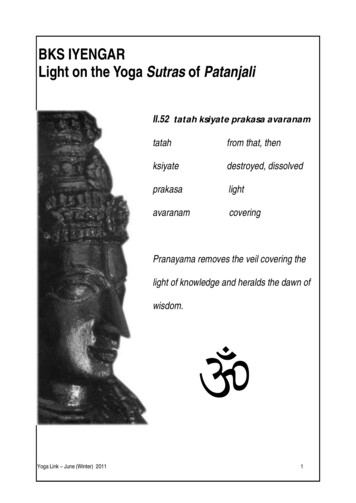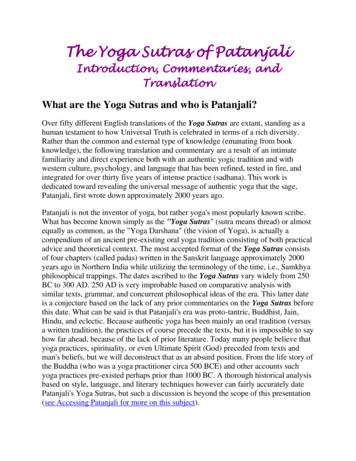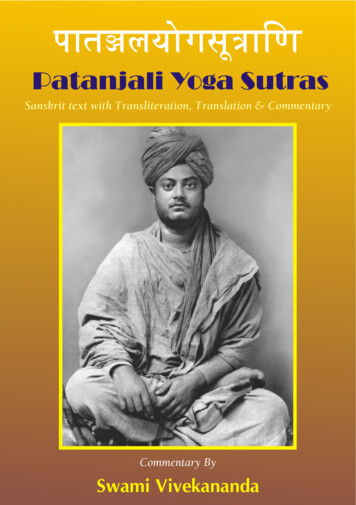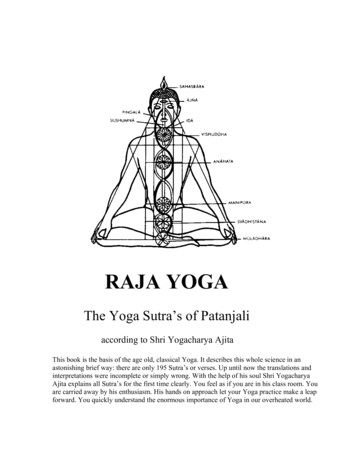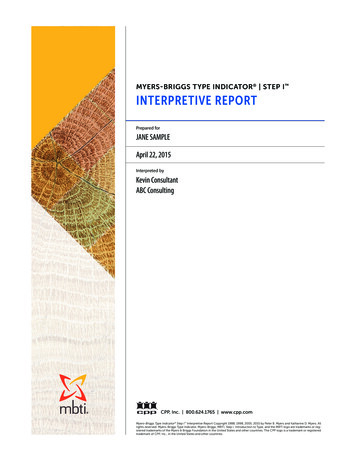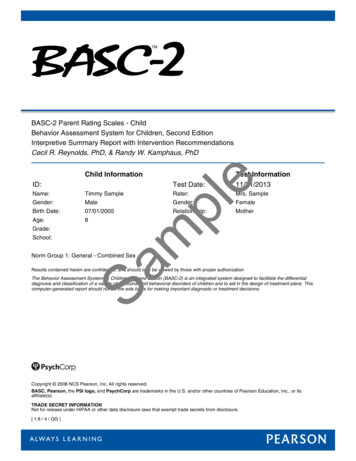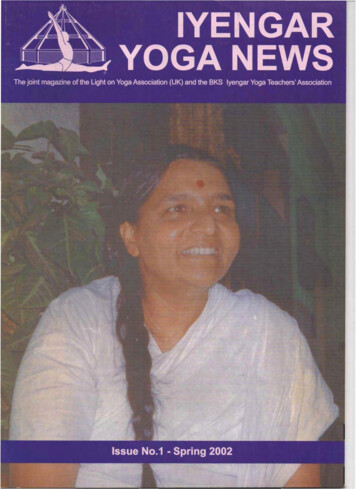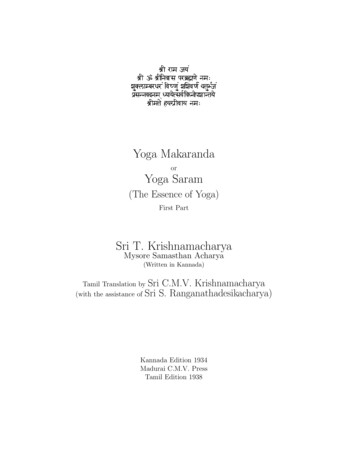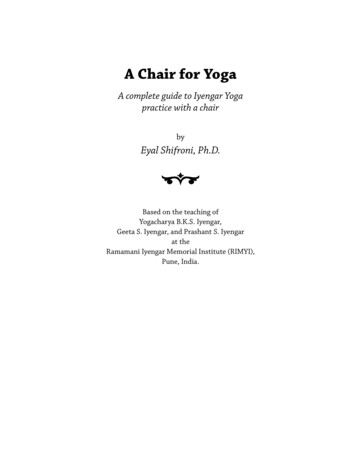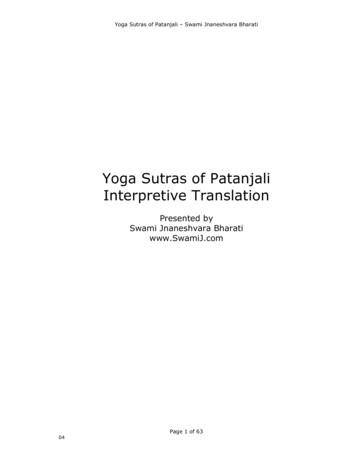
Transcription
Yoga Sutras of Patanjali – Swami Jnaneshvara BharatiYoga Sutras of PatanjaliInterpretive TranslationPresented bySwami Jnaneshvara Bharatiwww.SwamiJ.comPage 1 of 6304
Yoga Sutras of Patanjali – Swami Jnaneshvara BharatiYoga Sutras of Patanjali Interpretive TranslationPresented bySwami Jnaneshvara Bharatiwww.SwamiJ.comThe Yoga Sutras of Patanjali succinctly outlines the art and science of Yoga meditationfor Self-Realization. It is a process of systematically encountering, examining, andtranscending each of the various gross and subtle levels of false identity in the mindfield, until the jewel of the true Self comes shining through.This is an interpretive translation of the Yoga Sutra, expanding the number of Englishwords, so as to allow the practical instructions to be clearer. For example, sutra 1.2defines Yoga with some 25 English words, rather than only 4 Sanskrit words. Thepractices of the Yoga Sutras are extremely practical, though it can seem quitecomplicated when trying to sort through the language. By providing expanded,interpretive translations, the practical meaning of the suggestions more easily comesthrough. The individual transliterated Sanskrit words also have a large number ofEnglish translations, so as to give a more thorough understanding.Commentaries on the Sutras are on www.SwamiJ.com, as well as other learning aids.These include an extensive Introduction, a Main page presenting a visual outline andsummary of the entire Yoga Sutra, and a list of Reminder Questions, which serve as aself-study guide.When Patanjali codified, or compiled the Yoga Sutras, it was not that a new systemwas created, but rather, the ancient practices were summarized in an extremelyorganized and terse way. While the Yoga Sutras are thought to be as old as 400 BCE,archaeological evidence and other texts suggest that the methods described in theYoga Sutras were being practiced as early as 3000 BCE. Oral tradition states that theperiod may be even longer.Yoga means union of the parts of ourselves, which were never divided in the firstplace. Yoga literally means to yoke, from the root yuj, which means to join; it is thesame as the absorption in the state of samadhi. Sutra means thread, and this thread,or multiple threads weave a tapestry of insight and direct experience.Swami Rama explains, "There have been many scholarly commentaries on the YogaSutras, but all the commentaries miss something very practical. Such commentariescan only satisfy the intellect, but do not actually help you beyond that: 'yogash chittavritti narodha'--yoga is the control of the 'modifications' of the mind. Narodha meanscontrol; there is no other English word for it. Control doesn't mean suppression, butchanneling or regulating."In the tradition of the Himalayan masters, Yoga, Vedanta, and Tantra complement oneanother, leading one systematically along the path to Self-realization. The aspirantclears the mind through the practice of Yoga meditation as codified in the Yoga Sutrasof Patanjali, does self-enquiry of Vedanta, and then breaks through the final barrierwith Tantra, experiencing the heights of kundalini awakening.Page 2 of 6304
Yoga Sutras of Patanjali – Swami Jnaneshvara BharatiTable of Contents of Yoga SutrasChapter 1: Concentration (Samadhi Pada) . 4What is Yoga? (1.1-1.4) . 4Un-coloring your thoughts (1.5-1.11). 5Practice and non-attachment (1.12-1.16). 7Types of concentration (1.17-1.18) . 8Efforts and commitment (1.19-1.22) . 9Contemplation on AUM or OM (1.23-1.29) . 10Obstacles and solutions (1.30-1.32) . 12Stabilizing and clearing the mind (1.33-1.39) . 13After stabilizing the mind (1.40-1.51) . 15Chapter 2: Practices (Sadhana Pada) . 19Minimizing gross colorings that veil the Self (2.1-2.9). 19Dealing with subtle impressions that veil the Self (2.10-2.11) . 21Breaking the alliance of karma (2.12-2.25) . 22The 8 rungs of Yoga are for discrimination (2.26-2.29) . 26Yamas and Niyamas, rungs #1 and #2 (2.30-2.34) . 28Benefits from the Yamas and Niyamas (2.35-2.45) . 30Asana or meditation posture, rung #3 of 8 (2.46-2.48) . 32Pranayama and breath control, rung #4 of 8 (2.49-2.53). 33Pratyahara or sense withdrawal, rung #5 of 8 (2.54-2.55) . 34Chapter 3: Progressing (Vibhuti Pada). 36Dharana, Dhyana, Samadhi, rungs #6, #7, and #8 (3.1-3.3). 36Samyama is the finer tool (3.4-3.6) . 37Internal is seen to be external (3.7-3.8) . 37Witnessing subtle transitions with Samyama (3.9-3.16) . 38Experiences from Samyama (3.17-3.37) . 41What to do with subtle experiences (3.38) . 46More attainments from Samyama (3.39-3.49). 47Renunciation that brings kaivalya or liberation (3.50-3.52). 51Higher discrimination through Samyama (3.53-3.56). 52Chapter 4: Liberation (Kaivalya Pada) . 54Means of attaining experience (4.1-4.3) . 54Emergence and mastery of mind (4.4-4.6) . 55Actions and karma (4.7-4.8) . 55Subconscious impressions (4.9-4.12) . 56Objects and the 3 gunas (4.13-4.14) . 57Mind perceiving objects (4.15-4.17) . 58Illumination of the mind (4.18-4.21) . 59Buddhi, discrimination, and liberation (4.22-4.26) . 60Breaches in enlightenment (4.27-4.28). 61Perpetual enlightenment (4.29-4.30) . 62Knowables become few (4.31) . 62Gunas and liberation or Kaivalya (4.32-4.34) . 63Page 3 of 6304
Yoga Sutras of Patanjali – Swami Jnaneshvara BharatiChapter 1: Concentration (Samadhi Pada)What is Yoga? (1.1-1.4)1.1 Now, after having done prior preparation through life and other practices, thestudy and practice of Yoga begins.(atha yoga anushasanam) atha now, at this auspicious moment; implying the transition to this practiceand pursuit, after prior preparation; implying a blessing at this moment oftransitionyoga of yoga, union; literally, to yoke, from the root yuj, which means tojoin or to integrate; same as the absorption in samadhianu within, or following tradition; implies being subsequent to somethingelse, in this case, the prior preparationshasanam instruction, discipline, training, teaching, exposition, explanation;Shas implies the imparting of teaching that happens along with discipline1.2 Yoga is the control (nirodhah, regulation, channeling, mastery, integration,coordination, stilling, quieting, setting aside) of the modifications (gross and subtlethought patterns) of the mind field.(yogash chitta vritti nirodhah) yoga of yoga, union; literally, to yoke, from the root yuj, which means tojoin; same as the absorption in samadhichitta of the consciousness of the mind-fieldvritti operations, activities, fluctuations, modifications, changes, or variousforms of the mind-fieldnirodhah control, regulation, channeling, mastery, integration, coordination,understanding, stilling, quieting, setting aside of1.3 Then the Seer abides in Itself, resting in its own True Nature, which is called Selfrealization.(tada drashtuh svarupe avasthanam) tada then, at that time; at the time of concentration and meditationdrashtuh the seer's, of the soul, witness, Atman, Self; from the root drsh,which means to see (It is significant to note that Patanjali is not trying todefine who is the seer, or the nature of that seer. This is left to be answered orresolved in direct experience.)svarupe in its own nature, own form or essence; (sva own; rupa form)avasthanam stability, settling, remaining, being in a state, resting, standing,lying, abiding; the root stha means to standPage 4 of 6304
Yoga Sutras of Patanjali – Swami Jnaneshvara Bharati1.4 At other times, when one is not in Self-realization, the Seer appears to take on theform of the modifications of the mind field, taking on the identity of those thoughtpatterns.(vritti sarupyam itaratra) vritti of the operations, activities, fluctuations, modifications, changes, orvarious forms (of the mind-field)sarupyam similarity, assimilation, appearance of, identification of form ornature, conformity with the shape of; the root sa means with, and rupa meansformitaratra elsewhere, at other times, when not in that state of realization aboveUn-coloring your thoughts (1.5-1.11)1.5 Those gross and subtle thought patterns (vrittis) fall into five varieties, of whichsome are colored (klishta) and others are uncolored (aklishta).(vrittayah pancatayah klishta aklishta) vrittayah the vrittis arepancatayah five fold (and of two kinds); panch means fiveklishta colored, painful, afflicted, impure; the root klish means to causetrouble; (klesha is the noun form of the adjective klishta)aklishta uncolored, not painful, not afflicted, pure; not imbued with kleshas;the root a- means without or in the absence of; hence, without the coloringcalled klishta1.6 The five varieties of thought patterns to witness are: 1) knowing correctly(pramana), 2) incorrect knowing (viparyaya), 3) fantasy or imagination (vikalpa), 4)the object of void-ness that is deep sleep (nidra), and 5) recollection or memory(smriti).(pramana viparyaya vikalpa nidra smritayah) pramana real or valid cognition, right knowledge, valid proof, seeing clearlyviparyayah unreal cognition, indiscrimination, perverse cognition, wrongknowledge, misconception, incorrect knowing, not seeing clearlyvikalpah imagination, verbal misconception or delusion, fantasy,hallucinationnidra deep sleepsmritayah memory, remembering1.7 Of these five, there are three ways of gaining correct knowledge (pramana): 1)perception, 2) inference, and 3) testimony or verbal communication from others whohave knowledge.(pratyaksha anumana agamah pramanani) pratyaksha direct perception or cognitionanumana inference, reasoning, deductionagamah authority, testimony, validation, competent evidencepramanani valid means of knowing, proofs, sources of correct knowingPage 5 of 6304
Yoga Sutras of Patanjali – Swami Jnaneshvara Bharati1.8 Incorrect knowledge or illusion (viparyaya) is false knowledge formed byperceiving a thing as being other than what it really is.(viparyayah mithya jnanam atad rupa pratistham) viparyayah unreal cognition, indiscrimination, perverse cognition, wrongknowledge, misconception, incorrect knowing, not seeing clearlymithya of the unreal, of the false, erroneous, illusoryjnanam knowing, knowledgeatad not its own, not thatrupa form, nature, appearancepratistham based on, possessing, established, occupying, steadfast, standing1.9 Fantasy or imagination (vikalpa) is a thought pattern that has verbal expressionand knowledge, but for which there is no such object or reality in existence.(shabda jnana anupati vastu shunyah vikalpah) shabda word, sound, verbal expressionjnana by knowledge, knowinganupati following, in sequence, depending uponvastu a reality, real object, existentshunyah devoid, without, emptyvikalpah imagination, verbal misconception or delusion, fantasy,hallucination1.10 Dreamless sleep (nidra) is the subtle thought pattern which has as its object aninertia, blankness, absence, or negation of the other though patterns (vrittis).(abhava pratyaya alambana vritti nidra) abhava absence, non-existence, non-occurrence, negation
Yoga Sutras of Patanjali Swami Jnaneshvara Bharati Page 6 of 63 04 1.8 Incorrect knowledge or illusion (viparyaya) is false knowledge formed by perceiving a thing as being other than what it really is. (viparyayah mithya jnanam atad rupa pratistham) x viparyayah unreal cognition, indiscrimination, perverse cognition, wrong knowledge, misconception, incorrect knowing, not seeing clearly x .
